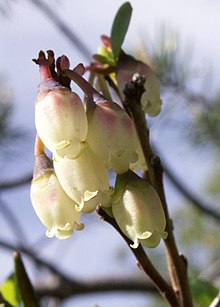| Vaccinieae | |
|---|---|
 | |
| Vaccinium uliginosum | |
| Scientific classification | |
| Kingdom: | Plantae |
| Clade: | Tracheophytes |
| Clade: | Angiosperms |
| Clade: | Eudicots |
| Clade: | Asterids |
| Order: | Ericales |
| Family: | Ericaceae |
| Subfamily: | Vaccinioideae |
| Tribe: | Vaccinieae Rchb. |
| Type genus | |
| Vaccinium L. [1] | |
| Genera | |
See here | |
Vaccinieae is a tribe of over 1000 species in the plant family Ericaceae. [2] The tribe consists of morphologically diverse woody plants. Species within Vaccinieae can be found on all continents except Australia and Antarctica. [2] Genetic analysis indicates that Vaccinieae is not a monophyletic group. [2]